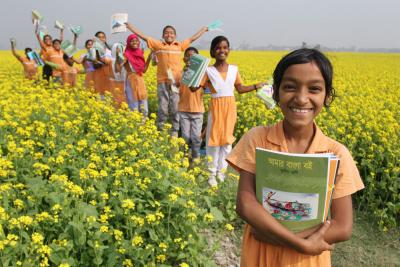DHAKA, March 21, 2018 (BSS)- The adult literacy rate has marked 26.10 percent rise in the past 10 years, taking it to a record high of 72.76 in 2016, according to the latest data of UNESCO Institute for Statistics (UIS) on Bangladesh literacy rate.
The data showed that the total adult literacy was 46.66 percent in 2007 when 43.74 percent female and 49.83 percent adult male were literate.
With this sharp rise in the total adult literacy in a decade, the percentage of educated male and female also shot up to 75.62 and 69.90 accordingly.
The data also revealed that the number of educated young male and female rose remarkably in the past 10 years.
The literacy rate among 15 to 24 years old men and women increased to 92.24 percent in 2016 from 61.87 percent in 2007.
The statistics also showed that 93.54 percent female from 15 to 24 years old become literate in 2016 when 90.91 percent of male of the similar age group were literate.
The phenomenal rise in literacy rate is one of the major factors that the Committee for Development Policy (CDP) of the United Nations considered for declaring the eligibility of Bangladesh for graduating from the Least Development Countries (LDCs).
According to the UIS, in the global literacy rate index, Bangladesh is ahead of many countries including India (69.30%), Nepal (59.63%), Bhutan (57.03%) and Pakistan (56.98%).
The UNESCO attributed the success to the Bangladesh’s government’s policy and fiscal support to the education sector, including the projects taken in the past 10 years for attaining a 100 percent literacy rate and improving the quality of education.
According to the UIS, the government doubled the expenditure for the education sector to $4399.5 million in 2016 which was $1993.5 million in 2008. However, the fiscal allocation for the education sector in the 2017-18 financial year’s budget was over $7885 million (Taka 65,444 crore).
According to the education ministry, the government has been implementing many projects since 2009 aiming at building skilled and competent human resources through creating opportunities of enrolment in all levels of education.
The government has also prepared the National Education Policy-2010 to ensure the rights and the opportunities of education for all.
To achieve the targets, the policy has emphasised on ensuring basic resources for education, digitisation of classrooms and textbooks, curriculum reform, introduction of creative question papers, infrastructure development and modernisation of madrasa education.
‘Sheikh Russel Digital Lab and Multimedia Classroom’ has already been established in over 37,000 educational institutions across the country.
More than 26,000 primary schools have so far been nationalised in a bid to set up public primary school in every village of the country.
In the secondary level, Upazila ICT Training and Resource Centres have been established and 295 non-government schools have been transformed into model schools in 315 upazilas.
Construction of new buildings for 5,500 non-government educational institutions including schools and colleges is going on.
On an average, the government distributes 35 crore 46 lakh textbooks among students across the country every year. Around 38 lakh students from 6th grade to bachelor degree (pass) and equivalent level are also provided with stipends and other assistances amounting over Taka 675 crore.



